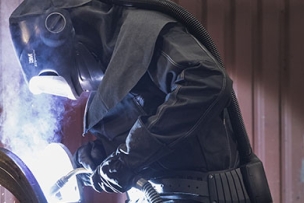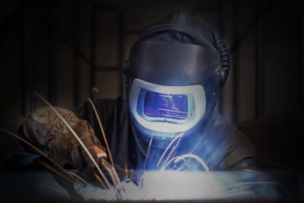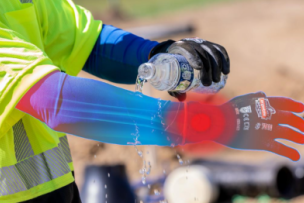Products that work as hard as you do. From the most basic to the most specialized needs, 3M offers the health and safety protection you and your workers need most, so everyone can perform at their best. We strive to deliver comfortable, well-designed personal protective equipment (PPE) that offers your workers the most effective protection available.
Silica is a natural substance found in rocks, sand, and clay and in products such as certain bricks and concrete. In the workplace, these materials can create dust when they are cut, sanded, carved, and ground. Some of this dust may be fine enough to breathe deeply into the lungs and may be associated with negative health effects, especially for workers with repeated exposure over time to high levels of this type of dust. The fine dust can include respirable crystalline silica (RCS), which is often too fine to see with normal lighting.1
There are many jobs and industries that grind materials that may produce respirable crystalline silica, including:
- Brick and tile making
- Construction
- Ceramics
- Foundries
- Manufacturing
- Quarries
- Stonemasons
How does Respirable Crystalline Silica Dust Exposure Occur?
Respirable crystalline silica dust can be created when cutting, sawing, grinding, drilling, and crushing stone, rock, concrete, brick, block, and mortar containing silica. Activities such as abrasive blasting with silica sand, sawing brick or concrete, sanding or drilling into concrete walls, grinding mortar, manufacturing brick, concrete blocks, stone countertops, or ceramic products, and cutting or crushing stone can result in worker exposures to respirable crystalline silica dust.2
Workers who inhale these very small crystalline silica particles are at increased risk of developing serious silica-related diseases, including silicosis, a serious lung disease that can lead to disability and death. Workers who have prolonged exposure to respirable crystalline silica may also be more likely to develop chronic obstructive pulmonary disease (COPD), other lung issues, and even problems such as kidney disease.3
What Do Current Silica Regulations in the U.S. Require?
To help protect workers exposed to respirable crystalline silica, the U.S. Occupational Safety and Health Administration (U.S. OSHA) has issued two respirable crystalline silica standards: one for construction, and another for general industry and maritime. These regulations require contractors to control their employees’ exposure to respirable crystalline silica and also set out a new, reduced Permissible Exposure Limit (PEL). The regulations also specify the need for employers to put together a written exposure control plan, parameters for medical surveillance, recordkeeping, housekeeping measures, and that a Silica Competent Person must be trained and certified to monitor activities on a job site to help reduce silica exposure, including providing training for employees.
Under these regulations, there is also a table of activities (Table 1) that specifies 18 different tools/tasks along with specified engineering and work practice controls, as well as respirator selection information. Contractors are required to “fully and properly” implement these controls unless they use the prescribed alternative exposure assessment methods discussed in the next paragraph. Respirators must be used in compliance with all other sections of the U.S. OSHA Respiratory Protection Standard (29 CFR 1910.134) and the respirator manufacturer’s user instructions. Table 1 footnotes must be followed to help ensure protection of the worker and compliance with the regulation, and 3M also strongly encourages you to review this technical bulletin. Employers should carefully review and follow all applicable regulations and other requirements, as well as consult a reputable manufacturer for help and information in selecting appropriate respiratory protection for their workers.
For tasks not listed in Table 1, or if the controls listed are not “fully and properly” implemented, contractors must conduct exposure assessments for each worker who may be exposed above the action limit and ensure they are not exposed to airborne concentrations above the PEL. Exposure can be assessed by either performance method using air monitoring and objective data collection or scheduled monitoring methods. For more information about this, please thoroughly review 3M's technical bulletin.
Silica Dust Control Measures
Exposures above the PEL must be controlled first by engineering controls (e.g., wet cutting, HEPA filtered local exhaust ventilation, etc.) and work practice controls. If those are infeasible or insufficient to reduce exposure below the PEL, then respiratory protection must be used.

Employers should also consider using abrasive sanding materials and equipment that helps cut down on dust production such as sanding disks with through-holes. These tools should be considered as part of the available engineering controls and containment methods such as abrasive blast cleaning machines and cabinets, wet drilling, or wet sawing of silica-containing materials to help control the hazard and protect adjacent workers from exposure. There should be regular inspections conducted of these dust control systems to help keep them in good working order. Jobsites should also employ good work practices to minimize exposures and help prevent nearby workers from being exposed. For example, remove dust from equipment with a water hose rather than with compressed air. Use vacuums with high-efficiency particulate air (HEPA) filters or use wet sweeping instead of dry sweeping.4
Additionally, workers should take the following personal hygiene practices into account to help protect themselves from crystalline silica and other contaminants such as lead, particularly during abrasive-blasting operations [NIOSH 1991a]5:
- Do not eat, drink, or use tobacco products in dusty areas.
- Wash hands and face before eating, drinking, or smoking outside dusty areas.
- Park cars where they will not be contaminated with silica and other substances such as lead.
Protective Clothing
Employees should also take the following steps to help ensure that dusty clothes do not contaminate cars, homes, or worksites outside the dusty area:
- Change into disposable or washable work clothes at the worksite.
- Shower and change into clean clothes before leaving the worksite.
There are a wide variety of control measures that can help reduce elevated silica dust levels, including those ranging from choosing tools that can help reduce dust creation to cleaning procedures as well as wearing appropriate respiratory protection equipment. For questions about implementing these measures and selecting respiratory protection for your worksite, please do not hesitate to reach out to 3M for assistance from their experienced team of health and safety specialists.
Previously Featured on 3M Personal Safety Division's Resources page.
References:
1 https://www.hse.gov.uk/pubns/indg463.htm
2 https://www.osha.gov/silica-crystalline
3https://www.youtube.com/watch?v=-kQmLYqIR2A
4 https://www.cdc.gov/niosh/docs/96-112/default.html
5 https://www.cdc.gov/niosh/docs/96-112/default.html









Talk to Us!
Leave a reply
Your email address will not be published. Required fields are marked *